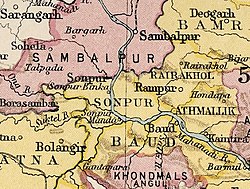Sambalpur State
| Sambalpur State ସମ୍ବଲପୁର / संबलपुर |
|||||
| Princely State of British India | |||||
|
|||||
| Former state of Sambalpur as a British district in pink in the Imperial Gazetteer of India | |||||
| History | |||||
| • | Foundation of the state | 1493 | |||
| • | Annexed by the British Raj | 1848 | |||
| Area | |||||
| • | 1901 | 1,399 km2(540 sq mi) | |||
| Population | |||||
| • | 1901 | 79,900 | |||
| Density | 57.1 /km2 (147.9 /sq mi) | ||||
Sambalpur, also known as Sumbhulpore and as Hirakhand, was a princely state in India during the British Raj. Its capital was in Sambalpur town, now in Odisha state. In 1849 the state was annexed by British India. Its area was 1,399 square km with a population of 79,900 persons according to the 1901 census.
Sambalpur State was founded in mid 15th century by Balaram Deo, a Rajput from Chauhan dynasty and younger brother of kingdom of Patna ruler Raja Narsingh Deo . In 1540 A.D., the kingdom of Patna, ruled by the Chauhan dynasty was bifurcated. The southern portion of the Ang River was ruled by Narasingh Deb and his brother Balaram Deb received the northern side of the river, known as Kingdom of Huma. Balaram Deb established his new capital at Sambalpur. Sambalpur was ruled by the Chauhan dynasty till 1800. The kingdom of Sambalpur was also known as Hirakhand and Sambalpur was its capital.
The Garhjat states were eighteen vassal states under Sambalpur State. The Sambalpur kings favoured Sarangarh State owing to the readiness of its rulers to help their kingdom during military campaigns. Sambalpur was ruled by the Chauhan dynasty till 1800 when Sambalpur came under the Bhonsle dynasty of Nagpur State.
Sambalpur was invaded and occupied by the Marathas between 1808 and 1817. After the Third Anglo-Maratha War in 1817 the British Government returned Sambalpur to the Chauhan king, Jayant Singh, but his authority over its eighteen vassal states was withdrawn. The state was placed under British administration from 1818 to 1820, when local rule was restored and the principality became a British protectorate. When the ruler or the state died without a direct male heir in 1849, the British seized the state under the doctrine of lapse.
...
Wikipedia

